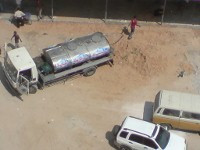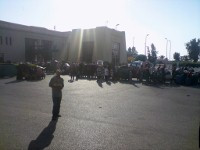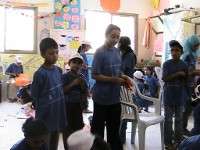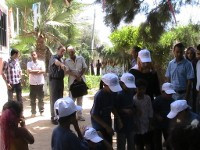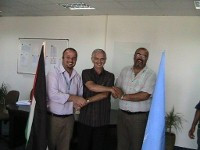Going that Extra Mile Resilience is all part of the job when living in Gaza but, although the residents there are trapped inside what is effectively a caged region, that doesn’t stop them thinking outside of the box as it were. And this was proved recently by some very special students at the Khan Younis Training Centre.
Their college dean is a very special man by the name of Dr Ghassan Abu Orf who had previously lectured at Sunderland University. While working in the North of England, he had involved his students in a prestigious event called Formula Student, a contest held annually by the fabled Institution of Mechanical Engineers and presided over by Formula 1 guru Ross Brawn, OBE. The competition is for students around the world to build a single-seater race car. But that is only part of it: the premise is simple ‘assume that someone has asked you to build a race car’. Then design, build, generate sponsorship and manage the whole project… That may be fine for a group of students in England, Germany or America but in Gaza where the average wage is between $2–3 dollars a day the problems start building up. But Dr Ghassan was not dissuaded and soon he had two groups ready to swing into action: one pulling together the engineering and one fund raising and looking after the business side. And this wasn’t an all-male affair, either.Mr Mohammed agha was the driving force as far as fund raising was concerned and helped raise several thousand dollars.Soon afterwards orders went out for the componentry needed for the design – but that is where the wheels started to fall of the project almost before it had even started… A big order for much of the racer’s running gear was placed in Italy but the company had no dispatch listing for Gaza and the parts instead went to the occupied West Bank where the Israeli authorities duly sent them back again. Dr Ghassan went out to Italy to see if he could help, but he could only bring the bare minimum in with him.
So, at the end of May and with the competition in mid July, a contingency was put into place using anything they could recycle to finish the job. So a crashed Honda motor cycle provided the power unit and water pipes made the tubes for the chassis. But it all came together so that at the beginning of July the tired band of students, who had been working non stop for days, could give their machine a test run. That they didn’t have any money to get them or the car to the competition mattered not: the feeling of accomplishment was reward in itself.
Good news is often hard to come by in a place like Gaza where many locals depend on UN food aid simply to survive, so when the car was given its first drive, it was picked up not only by local press but by Arab TV network Al Jazeera who featured it on their news broadcasts. Immediately, offers came in to help the group from way beyond the strictly enforced Gazan borders and, in spite of the inevitable trouble with visas getting them out, at the last minute the KYTC students and their car were on their way to England. Apart from Dr Ghassan, none of the 11-person team had ever stepped foot out of their homeland, which measures just 25 miles by 7 miles, but soon they were in Birmingham, before dropping down to Silverstone, just a week after it had hosted the British Grand Prix, for the contest.
Under the strict rules of the competition the team were penalised heavily for missing the deadline for submitting their design, which cost them a top-ten place in their division.but they won third prize for what was described as their “brilliant business plan”, which was part of the international racing competition in which they came an overall 13th. But it mattered not. Here was the living embodiment that ‘it is not the winning but the taking part that matters’. And even if the Gaza recycled machine didn’t have the clockwork-like precision of some of their well funded rivals, just about every other competitor came up to wish them well and, more importantly, offer help and materials for their next year’s project. Indeed the friendship and praise that was heaped upon them will live with the students for years to come.
And it didn’t end there. The team were invited down to London to visit the House of Commons by Christopher Gunness who works for UNWRA. Not even typically English mid-summer torrential rain could dampen their enthusiasm. But their effort is best summed up by Dr Colin Brown, Director of Engineering at the Institution of Mechanical Engineers: ‘It really is inspirational to see a team working so hard with the odds stacked against them like this. Formula Student is a massive challenge in its own right, but to be working with almost entirely recycled parts in one of the most deprived areas in the world is remarkable’.



